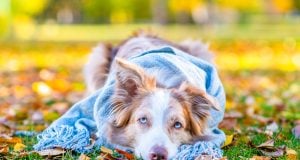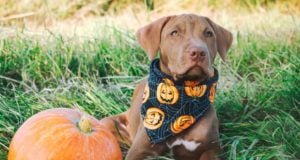Table of Contents
- Possible Autumn Dangers for Dogs
- Darker and Longer Nights
- Seasonal Allergies
- Seasonal Canine Illness (SCI)
- Alabama Rot
- Acorns, Fallen Fruits, and Leaves
- Conkers/ Horse Chestnut Tree
- Wild Mushrooms, Toadstools, Fungi
- Fleas, Ticks, Parasites
- Wildlife
- Fireworks and Sparklers
- Holidays (Halloween & Thanksgiving)
- Fall Decorations
- Planting Spring Bulbs and Other Decorative Plants
- Rat and Mouse Poison
- Antifreeze
- Mothballs
- Candle
- Heater
- Joint Pain
- Changing Routines
- Autumn Safety Tips for Dogs
- FAQs on Autumn Dangers for Dogs
- Autumn Dangers for Dogs: Final Thoughts
Just like any other season, there are Autumn dangers for dogs that fur parents have to look out for.
Not only can the cold, crisp weather bring colds to our dogs and cats, but many things associated with the fall season can also potentially bring them harm.
In this article, we listed down all the possible dangers to our dogs this Autumn season, from the most obvious to the most surprising and unexpected ones!
Possible Autumn Dangers for Dogs
Darker and Longer Nights
Along with colder temperatures, daylight hours decrease during the fall months. With less daylight, it's best to reschedule your regular dog walks to accommodate the change.
A lot of accidents happen in the dark—you can't be certain what might happen!
If you do have to walk at twilight or after dark, be sure to outfit yourself and your pet with reflective gear.
You can purchase reflective vests, LED harnesses, or LED dog collars to keep yourself and your pets safe.
If he has a microchip, ensure it's updated with all your information in case he gets lost in the dark.
Seasonal Allergies
Many pet parents believe that the threat of allergies decreases as the seasons change.
While a lot of foliage is hibernating for the winter, some allergy-causing agents are more prevalent in the fall than at any other time of year.
Mold, pollen, ragweed, dust, and grass are some of the common culprits of fall allergies in dogs.
If your dog suddenly develops rashes and is scratching excessively, sneezing, or has watery eyes and nose discharge, you should schedule an appointment with your vet.
There are many home remedies for mild cases, but if your dog has severe fall allergies, contact your veterinarian to determine the cause and what to do.
Seasonal Canine Illness (SCI)
This rare illness is considered a mystery even to experts because no one knows what causes it exactly, except that it always happens during the fall season, specifically between August and November.
It's also linked to woodland areas, where dogs start showing symptoms 24 to 72 hours after walking in the woods.
Some notable signs of Seasonal Canine Illness are vomiting, diarrhea, muscle tremor, and fever.
SCI can be quite dangerous if not immediately taken care of.
In the past, around 20% of dogs diagnosed with SCI did not survive, according to the now-defunct Animal Health Trust. However, with earlier detection and treatment, this number has dropped to less than 2%.
But still, we can never be too sure!
Alabama Rot
Another rare but potentially life-threatening disease is Alabama Rot.
Just like the SCI, the cause of Alabama Rot is unknown, but it's mainly associated with walking in muddy places.
Symptoms first appear as marks, sores, or ulcers on the legs and paws. If untreated, it could later cause problems with blood vessels in the skin and kidneys.
If it's too impossible to keep your dog away from muddy areas, make sure to wash and dry them thoroughly after their muddy session.
Acorns, Fallen Fruits, and Leaves
Any fallen things on the ground may seem harmless at first, but in truth, they may contain substances that are highly toxic to dogs.
Acorns, for example. They contain tannins that may cause an upset stomach and eventually could cause kidney and liver failure.
Beware of green acorns as they have more tannins than brown ones!
Trees also start dropping their fruits during this season, and if eaten by our pets, fermented and moldy fallen fruits can also cause discomfort.
Also, fruit seeds, pips, and fruit stones contain toxins that make dogs ill.
While it's cute seeing our dogs playing on a pile of dried leaves, fallen leaves also develop molds and bacteria that, when ingested, can lead to serious gastrointestinal problems in dogs.
Conkers/ Horse Chestnut Tree
Another common seed during autumn is a Conker, a hard, nut-like seed from the horse chestnut tree.
They are particularly bad for dogs because of the poison they contain, called aesculin. In rare cases, it can be deadly too.
Symptoms of conker poisoning may include vomiting with blood, diarrhea, drooling, tummy pain, increased thirst, and reduced appetite.
Conkers are also large and hard, which may cause your dog to choke or block his stomach and gut.
RELATED: What To Do If Your Dog Swallows Something He Shouldn't
Wild Mushrooms, Toadstools, Fungi
While there are plenty of mushrooms that are generally safe to eat for dogs and humans, wild mushrooms, toadstools, and any suspicious fungi that you see on your walks should be avoided at all costs.
Some toxic mushrooms can only cause upset stomachs at most, but other kinds could be poisonous and take effect in days, weeks, or an instant.
If your dog accidentally ingests one, take her immediately to the veterinarian. Keep a clear mind and don't panic!
Take a photo of the mushroom and take note of the environment where it's growing.
This will help the experts identify what type of mushroom has been eaten and how to treat it immediately.
Fleas, Ticks, Parasites
These parasites are a year-round problem for most dogs and their owners. Yes, they don't die in cold weather, just like we thought!
It's possible to pick up these unwanted hitchhikers on your outdoor walks from other animals, or even a pile of fallen leaves.
Apart from causing relentless scratching, fleas and ticks can also be carriers of different diseases!
Make sure to check your dog for any parasites after every walk, and keep up with your dog's yearly flea and tick preventatives!
RELATED: The Ultimate Dog Fleas and Ticks Survival Guide
Wildlife
Wild animals are also busy preparing for the cold weather, so they are more active this time of year. Be careful on daily walks and hikes!
Snake bites happen more often this time of year. Bear attacks are also more prevalent during the early fall.
Small animals can also be equally as dangerous because they can be carriers of several diseases.
Wildlife can be attracted to food sources, so be sure to pick up bird feeders, garbage cans, and anything else that might draw in hungry animals.
Always be aware of the native animals in your area!
Fireworks and Sparklers
Autumn season is also a time for celebration, and with that comes the fireworks and sparklers!
But be wary, because your dog will get stressed with all the noise.
Dogs can hear sounds 4 times farther away than humans can.
Not only that, but spent fireworks and sparklers also contain dangerous chemicals that, if left lying around, can cause breathing problems, blood in stool, and tummy pain, among others.
Glow sticks and luminous bracelets can also be quite attractive to our pets. They're pretty and colorful, but without the noise!
However, the liquid inside that makes them glow is irritant and toxic to both pets and humans. It can cause stomach aches and froth in the mouth if ingested.
Holidays (Halloween & Thanksgiving)
Our pets can certainly enjoy this spooky holiday. Still, there are elements in Halloween that might be too distressing for them, like Halloween costumes, noisy trick-or-treaters, and house decorations.
Those small figurines or creepy details you put out could be a choking hazard for them.
Plus, Halloween can also mean gatherings and strange visitors. For unsocialized pups, this could mean horror!
And don't forget the Halloween treats. Chocolates, sweets, raisins, and other candies are a no-no for dogs.
Thanksgiving also often involves family gatherings and lots of food.
If you're going to have a big crowd in your home, make sure your dog has a safe, quiet place to relax. Instruct your guests not to feed your dog human food and inform them of any pet rules you have in place!
You can also distract your dog by placing them in a crate or playpen filled with toys and their favorite chews.
Fall Decorations
Strategically place your decorations where your dog can't reach them. You can also buy and use dog-safe decorations!
Be mindful of wires, and keep them secure and out of reach of your pets. When you can't supervise your pet around holiday decorations, the safest option is to keep them kenneled or in another room.
Check your natural decorations regularly, and discard them when they begin to mold. Natural fall decorations, such as pumpkins, corn stalks, and hay bales, will rot over time.
Planting Spring Bulbs and Other Decorative Plants
Maintaining a beautiful garden can be a great way to cope with stress, but be sure to choose plants that are safe for dogs.
Spring bulbs (especially of Daffodils, Tulips, and Crocus) have concentrated allergens and toxins that may be harmful to them.
At the same time, autumn flowering plants like Chrysanthemum and Cyclamen can also cause vomiting, diarrhea, seizures, and death when accidentally ingested.
RELATED: Flowers Toxic For Dogs: 10 Beautiful Plants That You Should Look Out For
Rat and Mouse Poison
Rodenticides and pesticides become more common in the fall, as spiders, ants, mice, and other pests look for a warmer place to stay.
The Environmental Protection Agency (EPA) says that 75% of households in the U.S. use chemical pesticides in their home.
When you use these types of products made with toxic ingredients, the toxins get into the air and on virtually every surface in your home. And remember, these can smell enticing to your dog!
It's best to use natural products to keep pests out of your home and away from your yard.
Antifreeze
During the cold weather, you can't forget about maintaining your car.
However, some of the chemicals we use are highly toxic to our dogs. And by highly toxic, we mean instant death!
Antifreeze, for example, is actually sweet and palatable for our dogs. However, just a small amount of it can cause serious kidney damage.
Your dog will probably appear “drunk” right after drinking it before the worst thing can happen.
Mothballs
As you unpack your blankets and sweater-weather clothes, make sure that there are no stray mothballs lying around the house for your dog to find.
Mothballs contain a high concentration of insecticides. If ingested, it can cause anemia, vomiting, lethargy, and liver and kidney damage.
They can also be choking hazards if swallowed.
Candle
Lighting candles can be relaxing and decorative during this time of the year. But keeping one burning unsupervised is dangerous when you have a curious pup around.
Not only can your dog hurt himself, but he can also accidentally knock it down and burn the house.
Also, some candles release carcinogens and toxins while burning, which are potentially dangerous for dogs when inhaled.
Heater
The same goes for any heater you have in the house during autumn; your dog can hurt himself when he gets too close to it.
Fireplaces or space heaters should always be covered to prevent any over-excited pooch from burning itself.
Joint Pain
Dogs, especially senior ones, can also experience joint pains when it's chilly outside. Ensure they are warm and comfortable enough to prevent joint pains.
Changing Routines
Summer can be a hectic time for many families. Kids are home from school, adults take vacation time from work, and for many people, the summer months are the busiest of the year.
When fall rolls around, routines go back to ‘normal'. Kids go back to school, work schedules go back to normal, and things begin to settle down.
This change in routine is almost instant and can be difficult for pets to get used to.
If your pets will be alone for extended periods, ensure you compensate for their needs.
Take longer walks, make time for longer play sessions, or consider hiring a pet sitter. You may also want to consider doggy daycare if you have a high-needs dog.
Autumn Safety Tips for Dogs
Here are 10 tips to keep your dog safe this chilly season:
- Keep your dog warm.
- Make sure your dog is visible at all times.
- Preventive care is important!
- Steer clear of antifreeze, rodenticides, and any other toxic materials for dogs.
- Be careful with holiday treats.
- Keep a consistent routine as much as you can.
- Get your pet microchipped.
- Keep an eye out for wildlife.
- Consider joint supplements.
- Just cuddle with them on the couch!
FAQs on Autumn Dangers for Dogs
Do dogs like fall weather?
Actually, they do!
Dogs enjoy fall weather for the fun activities, and they can regulate their body temperature more effectively than in the hot seasons.
Can the change in weather make dogs sick?
Yes, it's possible.
Our dogs' respiratory systems play a big role in keeping them warm. When the weather gets too cold, it can constrict, too, like in humans!
Sneezing and nose congestion that come along with colds are also common in dogs.
How cold is too cold for dogs?
Dogs can generally regulate their body heat (thanks to their fur!), but extremely low temperatures can be too cold for dogs, too.
45° F or 7° C may be unsafe for small to medium-sized dogs with thin coats, but large breeds with heavier, double coats should be okay.
However, if the temperature drops further to 32° F or 0° C, you should already pay close attention to their well-being, especially pups, senior dogs, or dogs with preexisting conditions.
Autumn Dangers for Dogs: Final Thoughts
Autumn dangers for dogs are ever-present, as they are in other seasons too!
But this doesn't mean you shouldn't let your pup enjoy this fall weather. You just gotta be extra cautious to make sure that no harm will fall on your furry little friend.
Read more autumn or fall-related articles; check out our recommended topics below!




















